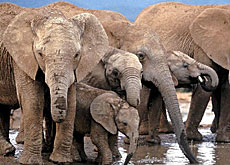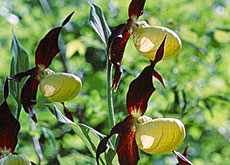More and more species face extinction

From the shark to the frog, the world’s biodiversity is declining at an unprecedented rate, according to the Swiss-based World Conservation Union (IUCN).
The question of how to halt that decline is the main focus of the union’s congress in Bangkok, which is being attended by delegates from around the world including Switzerland.
According to the IUCN, which has its headquarters in Gland in Switzerland, more than 15,000 species of plant and animal are in danger of becoming extinct.
Held every four years, the IUCN conference is one of the world’s biggest forums on research into endangered species. It also discusses draft guidelines for wildlife protection.
More than 5,000 government officials, scientists and conservationists, as well as 800 non-governmental organisations, are attending the nine-day forum in Thailand’s capital.
Red list
The conference coincides with the publication of IUCN’s “red list” of endangered species. This year, the number of plants and animals in danger of extinction totalled 15,589.
“The rate of extinction is much faster than it has ever been during the evolution of species,” said Olivier Biber of the Swiss environment agency, who is heading Switzerland’s delegation at the conference.
In a statement, the IUCN warned that nearly a third of all amphibians and almost half of all freshwater turtles were in danger of being wiped out.
It added that new research had also confirmed earlier findings that one in eight birds and a quarter of mammals were threatened with extinction.
People at fault
The IUCN says humans are mostly to blame for the decline in species because of the destruction of natural habitats and the introduction of foreign species, pollution and disease.
“Climate change is also a factor that has fairly recently been recognised as having a strong influence on the survival of species,” Biber told swissinfo.
“And there are species that are becoming extinct without us even knowing about them, as there are about two or three times as many species on earth as have been documented by scientists,” he added.
Biber said that nature conservation, as well as poverty reduction and education about wildlife preservation were all issues under discussion at the conference.
He said that although Switzerland had a few species on the endangered list, it was not a hot spot for biodiversity.
Among the most affected places are Asia and Africa. Islands with a high number of species or endemic wildlife were particularly affected, said Biber.
swissinfo, Isobel Leybold-Johnson
The IUCN produces its Global Species Assessment into trends in biodiversity every four years.
The IUCN is the scientific authority behind most intergovernmental treaties dealing with biodiversity.
The conference wraps up on November 25.
Bangkok also hosted a meeting on the United Nations Convention on International Trade in Endangered Species (CITES) in October.

In compliance with the JTI standards
More: SWI swissinfo.ch certified by the Journalism Trust Initiative











You can find an overview of ongoing debates with our journalists here . Please join us!
If you want to start a conversation about a topic raised in this article or want to report factual errors, email us at english@swissinfo.ch.